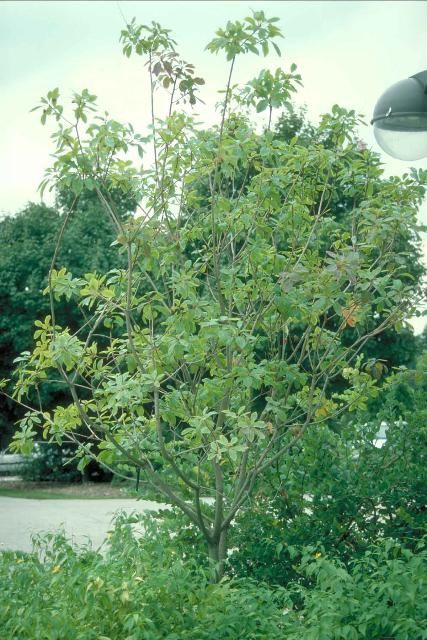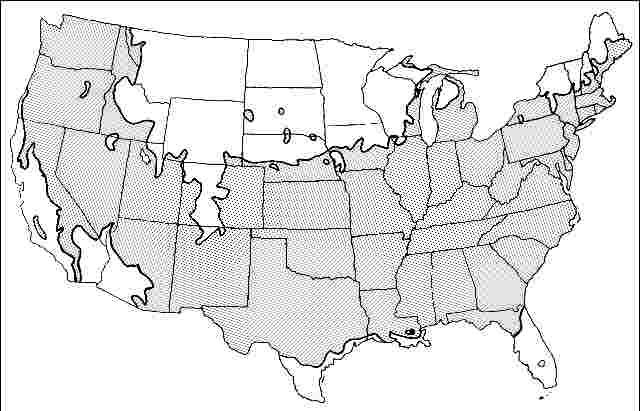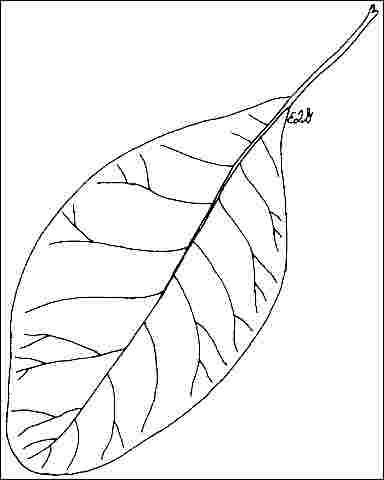Cotinus obovatus: American Smoketree1
Introduction
American Smoketree is most often seen as a large shrub 15 to 20 feet tall when grown in cultivation but can slowly become a 20 to 30-foot-tall, rounded tree with time, or in the wild. The bark on older specimens flakes off at the base of the trunk showing a dark grey to black exfoliating character. Multiple trunks eventually become twisted and gnarled. The 7 to 12-inch, fairly sparse, fuzzy panicles of springtime flowers give the plant an unusual, somewhat smoky effect but American Smoketree is most outstanding for its beautiful foliage. The five to six-inch-long leaves are pinkish-bronze when young, mature to a lush, dark blue/green then, in autumn, change into gorgeous shades of yellow, red, orange, or purple. Very striking in the fall, one of the best for fall color since it lasts three to four weeks. Enough cannot be said about the fall color - it must be seen to be believed. Not seen often enough in cultivation, American Smoketree may be in danger of extinction in the wild due to the large trees having been harvested for the yellow and orange dye found in their wood.

Credit: Ed Gilman
General Information
Scientific name: Cotinus obovatus
Pronunciation: koe-TYE-nus ob-oh-VAY-tus
Common name(s): American Smoketree, Chittamwood
Family: Anacardiaceae
USDA hardiness zones: 5A through 8B (Fig. 2)
Origin: native to North America
Invasive potential: little invasive potential
Uses: deck or patio; specimen; street without sidewalk; container or planter; reclamation; trained as a standard; parking lot island < 100 sq ft; parking lot island 100-200 sq ft; parking lot island > 200 sq ft; sidewalk cutout (tree pit); tree lawn 3-4 feet wide; tree lawn 4-6 feet wide; tree lawn > 6 ft wide; urban tolerant; highway median
Availability: somewhat available, may have to go out of the region to find the tree

Description
Height: 20 to 30 feet
Spread: 15 to 25 feet
Crown uniformity: symmetrical
Crown shape: round
Crown density: moderate
Growth rate: slow
Texture: medium
Foliage
Leaf arrangement: alternate (Fig. 3)
Leaf type: simple
Leaf margin: entire
Leaf shape: elliptic (oval), obovate
Leaf venation: pinnate
Leaf type and persistence: deciduous
Leaf blade length: 2 to 4 inches, 4 to 8 inches
Leaf color: blue or blue-green, green
Fall color: yellow, red, orange, purple
Fall characteristic: showy

Flower
Flower color: pink, white/cream/gray
Flower characteristics: showy
Fruit
Fruit shape: oval
Fruit length: less than .5 inch
Fruit covering: dry or hard
Fruit color: pink
Fruit characteristics: does not attract wildlife; showy; fruit/leaves not a litter problem
Trunk and Branches
Trunk/bark/branches: branches droop; showy; typically multi-trunked; thorns
Pruning requirement: needed for strong structure
Breakage: resistant
Current year twig color: gray, brown
Current year twig thickness: medium
Wood specific gravity: unknown
Culture
Light requirement: full sun, partial sun or partial shade
Soil tolerances: clay; sand; loam; alkaline; acidic; well-drained
Drought tolerance: high
Aerosol salt tolerance: low
Other
Roots: not a problem
Winter interest: no
Outstanding tree: yes
Ozone sensitivity: unknown
Verticillium wilt susceptibility: susceptible
Pest resistance: resistant to pests/diseases
Use and Management
Smoketree is best used in a shrub border, or trained as a multiple-trunked patio or accent tree. It can be pruned to provide clearance beneath to allow for pedestrians to pass or for use as a street tree. The tree should be used more often in American landscapes.
A North American native, American Smoketree is tolerant of a wide range of adverse urban conditions - wet soil, wind, drought, and compacted soil. Plants grow well and are native to high pH, alkaline soil and should be located in full sun or partial shade. Best flowering, form, and overall attractiveness is achieved in full sun. May need occasional irrigation on sandy soil. It is reportedly difficult to transplant but this is easily overcome by growing in containers.
The cultivar `Red Leaf' is popular for its especially brilliant fall color. Other cultivars selected for consistent and superior fall color are likely to be made available in the near future.
Propagation is by seed (with difficulty), cuttings, or layering.
Pests and Diseases
No pests or diseases are of major concern.


